In the spring of 2007, I met with a program officer from the David & Lucille Packard Foundation to discuss its sustainable seafood program over drinks at the Clift Hotel in San Francisco. As we took seats on a plush sofa in the cherry-red paneled RedWood Room bar, she shared some of the challenges of the foundation’s work, which aimed to scale back global overfishing and conserve marine fishery ecosystems. I was at the time what would be called a systems analyst for the nonprofit world: I worked for an organization called Ashoka and spent my time poring over sets of solutions addressing specific social or environmental problems to find patterns. Those patterns helped me provide strategic advice to foundations like hers. The request that capped her overview of the program was a common one: “Are organizations out there that we should be funding but aren’t because we don’t know about them?” In other words, find me some new pipeline. Perhaps emboldened by my strong cocktail, I lobbed back, “That is a great question. But what if the thing you really need to be funding doesn’t exist? How would you know that, and what would you do about it?”
“I don’t know”, she said. “What do you suggest?”
I excitedly laid out for her an approach I’d been discussing with colleagues that would pair the analysis I typically did for Ashoka with “design process”. We would find the holes in the ecosystem of solutions targeting overfishing and then use design to invent something new to fill one of those holes. By the end of my pitch for an approach, she was intrigued. She asked for a proposal within two weeks. The resulting document was beautiful and persuasive, if still risky and relatively expensive. Yet they loved it. With foundation support, my project team launched a research initiative that would span two organizations, 14 months, and multiple continents.
In the 10 years since that fateful conversation, I’ve convened and worked with multiple teams to apply design process to systems change, to found and build a nonprofit dedicated to that practice in fisheries, and to distill lessons from our journey so that the methods and insights can be applied to other complex, systemic problems. I did not, through most of that journey, have a name for what we were doing. The description of “applying design methods to systems change” proved so universally befuddling or off-putting to most of the marine scientists, fish industry business people, and nonprofit players I encountered that I simply stopped talking about that aspect of the work, instead focusing on the specific benefits or goals of individual projects. I joke that for many years I was under the impression that the name for what I was doing was, “You’re crazy and wrong”. When Carnegie Mellon’s head of school, Professor Terry Irwin, first told me around 2014 that I was practicing “Transition Design”, I was relieved to have a term for the work that also came with an emerging field of practitioners and academics pursuing this course.
In this paper, I’ll attempt to share the details of our Transition Design approach, what worked and did not, and lessons we were distilling from other disciplines. I am above all a practitioner, not an academic; references to the bodies of research work that contextualize this experience may not be exhaustive. I invite further discussion with academic and research colleagues as we continue to define this field.
A New Theory of Change
From the outset of the project, our goal was to use design methods to find ideas that were missing from the foundation’s existing quiver of strategies to counter overfishing. One of the dominant theories of change at the time was that if enough pressure from environmentalists and consumers forced big retailers (like Walmart, Target, and Costco) to buy fish that was “sustainable” (meaning harvested responsibly from stocks of fish with healthy population levels), then a “domino effect” throughout the supply chain would cause fishers everywhere to shift their harvesting practices. This theory was paired with policy change and regulation efforts as well; but the so-called markets strategy was where much of the energy of the nonprofit sector, including the financing from the three or four major foundations funding the activity, were directed. But what that program officer had articulated to me in our initial conversation was that the theory, some five years into its execution, seemed stuck. She said retailers reported that they had trouble finding sources of certified (or even averred) sustainable fish and trouble getting their suppliers to comply with their requests. Similarly, fishers reported that no monetary incentives existed for them to change behavior, which in many cases involved an expensive overhaul of gear and/ or business practices.
Our research team set out in September of 2008 to discover which interventions for sustainable seafood were working and what was missing from this ecosystem of solutions. The full analysis examined three sets of solutions in the field: (a) solutions targeting fishers to persuade them to change behavior; (b) solutions persuading major buyers of fish to change the kinds of fish they sourced; and (c) solutions engaging consumers to influence their purchasing patterns (Ashoka, 2009). This approach was based on creating a method and pattern recognition process to track how solutions in a given ecosystem cluster. The method’s strengths include that it identifies areas where few solutions are venturing; these areas of scarcity are holes that are ripe for innovation. It also distills the underlying reasons behind successful approaches, providing potential guidelines, or rules, for the creation of new ideas. The approach was developed as a way to help foundations craft or refine their approaches to grant making, but it turned out to be a perfect setup for the re-framing and ethnographic work required by the design process. It gave us both a map of the landscape of current activities and familiarity with the key players in the ecosystem.
The method works inductively from the solutions considered by identifying the myriad aspects of the problem they name; these are the barriers to change and improvement that need to be overcome. We also look at what insight, or design principle, underlies a given solution’s success. This is a qualitative analysis. The method does not seek to assign specific impact or create comparative quantitative success. It looks for the types of representative solutions that have cropped up in a sector. The resulting map reveals where the greatest amount of effort is deployed in a system. Figure 1, an example from the tool’s application to a later analysis of aquaculture, shows the outcomes of the process.
Once these three maps were drawn, we looked across them to identify areas of opportunity in the system, meaning places where not much activity resided but where the design principles might be useful. We arrived at eight opportunities that reflected a range of unexplored strategies that could potentially create leverage for change (Ashoka, 2009). At our recommendation, the foundation elected to dig deeper into the role of the middle of the supply chain. Out of the more than one hundred solutions we researched, not one reached out to distributors or processors. We theorized that this “black box” of the middle of the supply chain in the seafood industry would have some fruitful areas for exploration. Next, we considered where to ground the anthropological research. Ethnography is often used in design process to gain insights into human behavior for the following reasons, according to Charley Scull, one of the anthropologists on the original team:
It is a chance to see what people do, not just what they say they do. People are much better at showing you what they do than they are at telling you what they remember about what they do.
Ethnography pairs well with design, because it is deeply observational and interpretive, but it is not solutions-oriented in its construction.
It can provide a level of understanding that can help ensure that designs have contextual relevance.
It is rigorous and representative, because although researchers talk to individuals, they are looking for cultural patterns that are indicative of group behavior and have implications beyond the particularistic.
In typical design work, there is only one user to consider, as the frame of the problem solving is at a granular level of the system (See Figure 2). In contrast, we were looking for insights about many groups of users across the system. What things could we observe that would give us an understanding of what to design for the whole system, rather than for one user? How could we pick the right users and scenarios to observe? The team struggled mightily with these questions. Ultimately we defaulted to my instincts from my first career as a journalist on how to discover the juiciest story: Find the conflict. We decided to pick the place in the supply chain where interests were most in tension: the sale. We set up eight site visits in four different countries to observe fish changing hands in the supply chain. The siting of those observational contexts proved to be prescient (and lucky). The work of Donella Meadows, environmental scientist and systems thought leader, reinforced that our choice of what to observe corresponded with her list of places to intervene in a system (Meadows, 1999) (Listed in order of increasing effectiveness):
Constants, parameters, numbers
Regulating negative feedback loops
Driving positive feedback loops
Material flows and nodes of material intersection
Information flows
Rules of the system (incentives, punishments, constraints)
Distribution of power over the rules
Goals of the system
The mindset or paradigm out of which the system -its goals, power structure, rules, and culture- arises
Our observational choices put us in the middle of the key material flows of the fishing industry: the aggregation points of processing and distribution. It also exposed us to the critical information flows of the supply chain, tracking money and fish (See Figure 3). By narrowing our observation of “flows” to a specific transaction point, we were able to analyze what transpired in a potentially catalytic moment for the system. What kind of information was present or missing at the point of sale? What cultural and business values were present? What power dynamics were present? These exchanges (in this case, literal transactions as well as figurative ones) proved to be an observational goldmine, with broad implications for groups of users. By using ethnography in these specific microcosms of system behavior, we uncovered patterns of dysfunction in the system, as well as behaviors and beliefs that limited the ability to produce more sustainable outcomes.
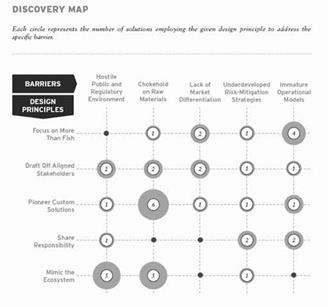
Credit: Breakthrough Aquaculture: Uncovering solutions that drive commercially viable models for farm-raised seafood (Future of Fish 2014).
Figure 1 This map charts the solutions responding to the question, “How might we foster a business landscape where ecologically sound and innovative aquaculture can scale and thrive?” The solutions we chose identified the barriers to this end state, listed across the horizontal axis. The solutions identified the underlying design principles listed vertically. Each circle contains the number of solutions we found that address the barrier in that column with the intersecting design principle. Columns with few solutions often indicate the barriers that are hardest to address and require collective action to move. A row with many solutions indicates a particular design principle has gained significant traction, suggesting that it might be a useful one to use to guide creation of new solutions.
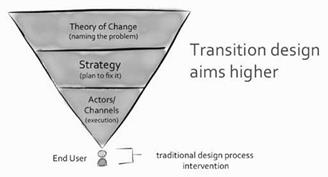
Figure 2 Designing for a theory of change. Design process has traditionally been applied at the level of one user in a system. We attempted to apply it at the broadest level to augment a theory of change for system intervention. Credit: Dahle.
One of the most compelling observations we made in the field was at a U.S. fish processing facility with upwards of $100M in sales (See Figure 4). The ethnography team arrived at 5 a.m. to watch fish being sold. The sales manager sent out an Excel spreadsheet via email with the day’s available fish to all of the sales reps, some of whom were in remote offices. All day, those reps sold against the static document without recording their sales in a centralized place. And they sold using the primary channel of fish sales -the phone.
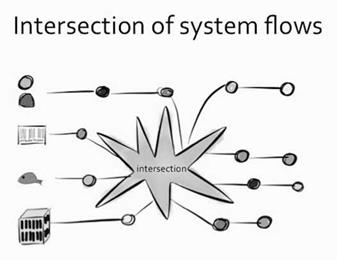
Credit: Dahle.
Figure 3 Crossroads. The observational moments we chose to include in our ethnography were intersections for multiple system flows: people, data, fish, and institutional influence.
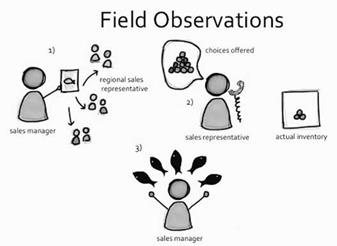
Credit: Dahle.
Figure 4 Ethnographic observations. We observed the sales manager hand off static sales tracking tools to the team (1). Sales staff sold against that static document all day, not recording dynamic sales. Inevitably, inventory did not match the sales closed (2). As a result, the sales manager called customers back and “negotiated” substitutions, obscuring the real reason for the scarcity.
Predictably, at the end of the day, some categories of fish were oversold and others were undersold. Then the sales manager decided which customers got what they actually ordered and called back the ones who were picked for substitutions. Often, the conversation was full of white lies: “the truck broke down”, “that supplier hasn’t been reliable lately”, “between you and me, that fish doesn’t look as good as what I’d like to send out to you”.
The manager would knock a little off the price, give the illusion to the slighted customer that they were a priority, and get permission to swap in a different fish. What we mostly witnessed was the benign version of a workaround. Less scrupulous middlemen simply take the skin off the fish and ship it with the label of the requested fish. Fish is such a complex product that even most chefs can’t tell the difference once the skin is off (See Box “A Few Facts about Fish”). This mismatch of supply and demand is created by the gap between consistent, unadventurous consumer demand and variability and seasonality of a wild resource; what comes up in the net is somewhat unpredictable. But consumers (particularly in the United States) want the same five fish every day, according to the National Fisheries Institute. Middlemen (processors and distributors) are stuck trying to manage demand (the benign behavior we witnessed) or cheat their way around it. The high-touch transactions with the customers we witnessed made buyers feel well serviced, when, in fact, the purpose of the substitutions was to disguise scarcity. Of particular significance is the observation that to have the opportunity to use this “back door” for negotiation or fraud, a seafood company must have weak technology. Good tracking technology would easily illuminate that the books did not reconcile for “type of fish in” and “type of fish out.” Our observations had illuminated a very problematic behavior in the system. If the hypothesis underlying the dominant theory of change was that pressure on retailers would “ripple” through the supply chain, here was a key player with significant business incentives to resist. That resistance was preventing the alignment of market incentives to the desired system outcome of more responsibly harvested fish. If fish move through the supply chain without being reliably paired with accurate information about catch method, species, and other key data elements, then the value of more responsible fisher behavior cannot earn a better price. When data is lost, all fish simply becomes a commodity and sustainability has no chance to create value and, in turn, drive behavior.
| A FEW FACTS ABOUT FISH For those not familiar with the environmental crisis facing the world’s fisheries, here are some facts to shape the context of our challenge: |
|---|
| - Ninety percent of the world’s fisheries are overfished, or fished “at maximum capacity. |
| - We have lost 80 percent of our large predator fish, such as sharks and large tuna. |
| - Industry is enormously wasteful. More than 28 million metric tons (MT) of bycatch are caught and disposed of annually. |
| - The industry has a significant problem with fraud and mislabeling. About a third of all seafood is mislabeled. In the United States, if you buy red snapper, it is truly red snapper only 13 percent of the time. Mislabeling rates in sushi restaurants are upwards of 84 percent. |
| - Illegal fishing is a significant issue. Ninety-seven million MT of wild fish are landed annually. An additional 28-33 million MT of illegal fish is caught over and above the legal quotas. Illegal fishing is difficult to police in large part due to the terrible data tracking in the seafood supply chain. Most seafood is still landed and recorded using paper and pen. It’s very easy to hide if you’re already in the dark. |
| Sources: NOAA, Oceana, Fish and Agriculture Organization of the United Nations |
The two strongest insights from the ethnographic work were the need for better supply chain traceability technology and the need to embrace the concept of fish with a story, or “storied fish” as opposed to “sustainable fish”. At the time, less than 10 percent of fish globally was certified sustainable, and multiple competing definitions of sustainability from the nonprofit sector made finding responsible seafood difficult and confusing for both industry buyers and consumers. We posited that acclimating consumers to having any data at all about their fish, and using the information they cared about to appeal to them, would in turn put more pressure on companies to improve technology. Improved technology would reduce fraud and mislabeling, as well as making sneaking illegal fish into the legitimate supply chain more difficult.
How did these insights translate to actual change in the world? We had originally (and perhaps naively) predicted that once the new insights of the report were made public, existing nonprofits in the fish world would be eager to adapt their strategies. We also (naively) assumed that the foundation planned to tweak its existing theory of change based on the work. The reality was much more complicated. The ideas in the report, particularly our insistence that the middle of the chain was crucial to change efforts going forward and that technology was a pivotal solution, were met with reactions ranging from tepid enthusiasm to outright hostility. The founder of one of the most prominent and respected non profits working on retail partnerships in the seafood industry said that one could “take the entire middle of the chain and wad it up into a ball and throw it away and it wouldn’t make any difference” to driving sustainability. When the program officer who had funded the work introduced our initial report to a crowd of fish nonprofit leaders at a conference, she equivocated, “Just because we funded this report doesn’t mean we agree with it”. The comment was not intended to undermine the work but to acknowledge that the process of adjusting a theory of change within a powerful foundation often involves a layered process of board sponsorship, executive buy-in, and extensive review at multiple levels. The radical shift in thinking we advocated would have required an engagement strategy on our part, which we had not considered or developed. All the same, the response in the room was not warm. The field of organizations was threatened by the disruptive insights and saw them as risky anomalies. The foundation was not ready to embrace the shift, which meant the report was essentially orphaned, with no one to implement the ideas inside it. We needed an intermediate step. We needed a pilot project to test the ideas we had delivered. I offered to do that and the foundation agreed.
So often, the ideas generated by beautiful design processes are never translated into the real world. They become missed opportunities. In this case, we didn’t have the clarity we do now (after testing concepts in the field) about which of the insights or ideas was most important, so the report wasn’t easy to explain or digest. The report landed as a collection of misfit toys with which no one was quite sure how to play. We also did not understand the dynamics of nonprofit clusters and the degree to which they are competitive with each other for funding. Disruptive ideas from the outside are often rejected; they represent capacities that existing organizations do not have and hence a potential shift away from funding their core competencies. Innovation threatens. I will circle back to those lessons and their implications in the last section of this article.
I launched Future of Fish as a nonprofit initiative in May of 2010, with seed grant funding from the Packard Foundation to explore and prototype the ideas in the report. Each round of funding was slightly longer than the last: three months became six months, became annual. In all, we received three years of funding from Packard. It took us roughly four years to be seen as a credible player in the nonprofit fish arena and to garner funding from other foundations. Much of that became possible only because I quit speaking publicly about systems change in fish contexts or about projects based on what was initially seen as an oddball, long-term strategy for change. I simply talked about project outcomes and impact and tried to do enough successful work that tracked to foundations’ existing priorities and metrics, while trying to forward our lone agenda for better technology. The rest of the sector has now “caught up” to our theory on the importance of technology. The field has gone from virtually no funding supporting interventions to push technology in the seafood sector when we entered in 2010 to a steady and growing set of commitments from foundations. For example, the first recorded grant from the Gordon and Betty Moore Foundation in this area was in January 2014 to the Global Food Traceability Center. Future of Fish then landed its first technology grant from Moore as well in October of that year, according to the foundation’s web site. In January of 2017 we became one of four organizations awarded a joint grant collaborating on efforts to educate and push traceability in the seafood industry, totaling $5M. Another multi-million-dollar collaboration is in the pipeline from USAID and others supporting the Seafood Alliance for Legality and Traceability (SALT), according to the collaboration’s web site.
As is often the case with innovation in nonprofit sectors, smaller players (like Future of Fish) identify needs and larger organizations with more capacity adopt those ideas and scale with broader impact. The line between the work of the small organization and the systems-level changes is difficult to measure. We know Future of Fish contributed significantly. Would the whole sector have moved faster had Future of Fish been able to land the insights from our initial work in a more powerful, supported, and formal context of system shifting? At the time we did not know how to make the right case for that support. I am hopeful that the burgeoning field of Transition Design can help groom philanthropies and other stakeholders to embrace this kind of work in the future as a legitimate tool for developing theories of change and strategy.
In the next section, I’ll explain what form our organization took and the strategies we’ve used to continually exert leverage in the system, without a formal endorsement. This is a reality in many settings -the change is driven by someone who has relatively little system power.
Not Exactly Incubation
Our first convening for Future of Fish in San Francisco was atypical in several ways. I chose a hotel with condo units that had multiple bedrooms, bathrooms and giant living rooms, and we met in one of the living rooms, sitting on the couches with a view over looking Ghirardelli Square. Attendees had to share suites and get to know each other. The group was an eclectic but passionate collection of about a dozen innovators: a professional chef, an executive from National Geographic, a technology marketer, a few fish processors and distributors, a few nonprofit leaders, and a First Nations fisherman from Alaska whose people had been fishing in the Cordova Valley for 3000 years. The one thing that all of the attendees had in common was what I call an “entrepreneurial mindset”. Whether they worked in nonprofits or start-ups or big companies, they all had openness to new ideas, excitement about the possibility for change, and curiosity about each other’s work. This attribute of entrepreneurial mindset has become a staple of our vetting process for participation in our design workshops.
Our initial report suggested multiple ideas for organizational interventions and argued that just one would not have the ability to effect systems change. Rather, we submitted that building a platform capable of supporting multiple interventions, like a machine that would continue producing solution after solution, was necessary. We used the word “incubator” in the report, which led to some misconceptions about what we were up to. We were incubating systems change, but most incubator models nurture organizations. They measure their success by the growth of their portfolio organizations, the amount of money invested, and the impact of those organizations. We were incubating disruptive ideas, which did not have the same measures. We selected a cohort of innovators and entrepreneurs (and intrapreneurs) in the seafood sector from our first workshop whose work supported our two levers of storied fish and traceability technology. Over time, we added multiple cohorts, all of which supported one of our two original leverage points. The purpose of the cohorts was three-fold. First, naming and supporting the group to network together raised the profile of their work and increased the chances that it would be noticed by media and other players in the sector. We began writing recommendations regularly for awards and fellowships for our cohort members as part of this effort. Second, the cohort gave them a community to support mutual progress and camaraderie. Even though some of the members technically competed, they had more in common with their fellow disruptors in their aims to change industry practices than they did with the business-as-usual players in industry. We were vigilant about ejecting cohort members who in any way violated the trust of the group, which led to a widespread perception that we worked with people of integrity. The support of the community and Future of Fish has been named to us many times informally as making the difference for entrepreneurs between giving up or pressing on. Third, we were able to provide strategic advice and business modeling for some members, as project fund availability allowed. Our model focused heavily on this third component during the first two years, until we realized how expensive and difficult that work can be and how narrow the success metrics are for funders who support incubators.
The emphasis on demonstration projects of disruptive ideas as a means to drive change was an intuitive one for me personally, having written about innovation and change management in business for years as a journalist. The concept seemed unfamiliar, too indirect, and too long of a lead-time for impact for many funders. Many said in early years that the projects we were supporting did not have the power, size, or influence to drive change. And yet, small interventions consistently spur big change. Professor F.W. Geels, at University of Manchester, put forward a theory of how society embraces socio-techno change, or shifts that require changes in both behavior and technology (2005). Geels (2005) and his colleagues theorized that change
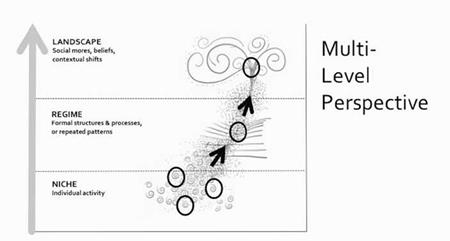
Credit: Dahle, Geels.
Figure 5 In this multi-level perspective, created by Geels et al. (2005), change percolates through layers in a system, often starting with disruptive activities that are outside the mainstream behaviors. As those take hold and prove to be more efficient, effective, or value creating, they begin to re-shape formal processes in a system, such as supply chain practices. In our case, we incubated seafood entrepreneurs whose use of story or technology was proving at a small scale to be beneficial or profitable for their companies. We also selected key individuals with platform, meaning access to distribution methods to share disruptive messages, either through business channels or media channels.
unfolds through a system as niche activities, like demonstration pilots and disruptive companies, find some traction, and begin to affect the formal processes that are part of a system, for example, business supply chains. Over time, the changes embraced in formal structures lead to changes in mindset and/or the broader social landscape and context. Our experience has borne out Geels’ model (See Figure 5). Our cohort members were one set of “niche” activities that we incubated and amplified, through our technical assistance and message boosting. We also undertook select projects as an organization to bolster the public and business cases for traceability technology and storied fish. That work included publishing research reports, such as our 2015 report “Getting There from Here: A Guide to Seafood Traceability.” The report was the first of its kind to name the specific business areas in which seafood companies could expect to add benefit or recoup costs from their traceability investments, as well as case studies from organizations that had experienced wins from implementing better technology. Additionally, we assisted cohort members with implementation of the projects they had designed while working with us. That role has often meant filling “gaps” in the skill sets and capacities in the field to execute. Our team’s composition has fluctuated over time to provide a range of services to the system, from storytelling and media creation to technological consulting to project management. Several of our current projects involve working in fisheries in developing nations where the state of the fishery necessitates a complex and holistic process that simultaneously considers the governance of the fishery, its data-gathering capacity, possible financing mechanisms, and government regulation all at once. Future of Fish has become, in essence, a general contractor that can assess the capacity and health of a fishery with respect to all of these dimensions and then recruit the partners necessary to work in collaboration. Most fisheries work has previously tried to work on one or two elements of this puzzle at a time and few nonprofits are able to position themselves as fluent in all of these areas with the networks and project management expertise to support the activity.
This approach of “filling the gaps” is a conscious emergent strategy on our part. As a result, we are a very fluid organization that is flexible and adept at navigating change. However, that fluidity also makes us hard to read for funders and colleagues. Most nonprofits settle into a specific set of activities and deepen their capacity. We have moved through phases of being entrepreneur coaches to technology analysts to project implementation experts. Through it all, we have developed a core set of skills around design process, which we use relentlessly in the field and in our work. We retain an anthropologist on our team and always look to integrate ethnography into our projects, which gives us empathy and tactical insights that other organizations do not gather. Essentially, we are constantly moving to the next behavioral stuck point in the system, though we are still nurturing seeds we planted in our first year of existence as well. The timeline for systemic change is long, far longer than the three-to-five-year result windows many foundations favor. Only now, seven years into our work, are some of our niche activities beginning to touch formal system processes and re-shape them.
Two of our strongest examples of niche work moving into the regime level are entrepreneurs Barton Seaver, a chef and sustainable seafood advocate, and Tom Kraft, a seafood industry entrepreneur.
We met Seaver in 2010 at our first gathering. We had interviewed him for the systems research we did for the first phase of the work and were impressed by his articulate passion for both fish and the communities of people who relied on marine economies for their livelihoods. Seaver had previously owned a restaurant in Washington, D.C., called Hook, which was renowned for its policy of buying fish locally and basing its menu on what came up in the net, not what a menu plan dictated. He tells a story of once receiving boxes of fish that he didn’t order or even recognize, a small bony fish he’d never seen before. He called his supplier, who called the fisherman. The supplier then rang Seaver back to say that the fisherman had had a rough day out on the water and hadn’t caught anything. Instead, he sent the bait, which turned out to be a small subspecies of flying fish, a difficult-to-filet specimen with little meat to it. Seaver gamely fileted 50 pounds of the fish and turned it into an appetizer. Importantly, he told his wait staff to share with diners the story of the fisherman’s bad day and that the fish was bait -because sometimes that’s what happens when we gather food from the unpredictable, wild ocean. He sold out of the dish in less than two hours at $26 a plate. Here was a master storyteller who could make people care about fish and the complex narrative behind its presence on a plate.
We set out to help Seaver build a business model for becoming a global chef advocate. Though he had been an Esquire Chef of the Year and National Geographic Fellow, he had no desire to become a celebrity and wanted the focus to be on the message, not his personality or charisma. In the beginning of our relationship, that meant loaning a project manager to Seaver while he went on his first cook book tour to help him optimize the press and exposure. Later, we helped him write proposals for partnerships and fellowships, positions that would elevate his expertise and leverage his culinary knowledge. He evolved into a sought-after consultant for recipe-development for packaged food companies, for sourcing advice for restaurants, and for messaging and branding advice for seafood companies. We secured a contract for him to build a video curriculum for restaurant chefs. We provided business modeling for multiple rounds of for-profit and nonprofit versions of scaling his work, some of which moved forward, while others did not. He landed a plum appointment at Harvard University’s T.H. Chan School of Public Health as director of the Sustainable Seafood and Health Initiative at the Center for Health and the Global Environment. He’s published seven books while working with us, six cookbooks and in November of 2017 a storytelling masterpiece about the history and community of domestic seafood called “American Seafood: Heritage, Culture and Cookery from Sea to Shining Sea” (Sterling Epicure, 2017). Our mission with Seaver has simply been to get his message into as many formats and forums as possible, scaling his storytelling by finding platforms where it can live without his personal presence or re-shaping business practices of those he touches. Our roadmap for Seaver came from the user typology we created in the original research. A common design process technique is to map the range of user mindsets related to the service or experience being designed. We weren’t designing a single service or object, so we instead mapped mindsets of all users for the outcome we were trying to create: system change (See Figure 6). We noticed that the multiple users in the “catalyst” quadrant all shared the characteristic of possessing story. Whether that meant that, like Seaver, they were great storytellers, or that they collected data to shape a narrative, all of them had some information to share with the system producing overfishing that could potentially drive change. We also noticed that both the upper and lower quadrant players on the left side of the diagram had what we called “platform”. As businesses, they had a network of connections and relationships, or their position in the supply chain meant they controlled a significant amount of distribution, of both product and data. We theorized that connecting these “catalysts” to other players with platform could be a path to scale that did not necessarily involve growing large companies.
We took a similar approach with Kraft. The founder of Norpac Fisheries Export, Kraft appeared on our radar in 2011. Kraft has an unusual pedigree for the seafood industry, which is dominated by family-owned businesses and people who’ve spent their whole careers in fish. Formerly an auditor for a large accounting firm, Kraft was long familiar with how business tracking systems worked in multiple industries. When he found himself running a fish distribution company in Hawaii, he realized that the industry’s Wild West approach to tracking data and product was far from the norm in other sectors. As a businessman, he was frustrated by the difficulty that the lack of systems caused for managing his operations. In 2004, he started building his own technology system internally, suffering through all of the typical difficulties of pioneers of new business practices. In addition
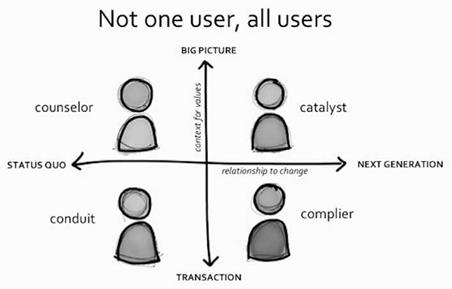
Credit: Dahle.
Figure 6 Typology of multiple users. This analysis depicts mindsets of multiple users of the system that produces overfishing toward change. We also noted in our research that catalysts possessed “story,” meaning the storytelling skills or the information to make a persuasive case for change. Actors on the left side of the 2×2 had “platform,” or the means to distribute information, product, or ideas to large networks. This analysis inspired our approach to helping catalysts build and connect to platform.
to the software platform, he also had to design a new workflow for plant employees and integrate the bar code scanners and hardware that could mesh the physical activity and movement of the fish to the digital records generated. After Kraft joined our cohort, we paid for a supply chain data consulting team to assess the product he’d built for its market potential as a commercial product. The recommendation came back that he needed to do some significant overhauling of the code. We didn’t have the money to support that project, nor was it investible as a skunkworks internal team initiative. Kraft kept plugging away and began to implement the tool with his supply chain partners once he had a new version of the tool. Today, that technology has become Insite Solution, one of a small number of technology tools designed for the seafood industry. The market for technology in the industry is still nascent, but Kraft has managed to become a leader in the field, winning a 2012 Seafood Champion Award for his efforts in promoting both sustainable fish harvesting and a new era of digital tracking.
How do we measure the impact of system catalysts like Seaver and Kraft? Seaver’s media impression based on his prolific publishing, in magazines as his books, easily reaches into the millions. Is that what’s relevant? Maybe we measure the impact of the sustainability sourcing policies he’s designed for campus and hospital dining services? For Kraft, how do we capture his influence in making a whole new market (technology for seafood) possible? How might we quantify his effect in socializing the traceability conversation with other industry executives at dozens of seafood conferences over the years? Measuring systems change, or even progress in realigning a complex system, is no easy feat. The metrics that work for simpler endeavors just don’t apply. While Future of Fish does have versions of strategic plans with the key progress indicators that foundations invariably ask for in their reports, I’ve never been satisfied with the quantitative approach to measuring systems change. Figures 7 and 8 feature an initial framework of understanding for how one might map the journeys of system catalysts like Seaver and Kraft as their ideas (not their companies, necessarily) scale and begin to affect the top layer of Geel’s multi-level model. In Figure 7, the left side of the diagram categorizes types of activities that correlate to potential impact in the corresponding layer on the right. Figure 8 maps some of the milestone for both Seaver and Kraft as their influence grew, with aid from Future of Fish’s analogous amplifying activities. Figure 9 charts some of our amplifying activities, as well as influential developments or projects initiated by other system participants. To be clear, Seaver’s and Kraft’s successes have been driven by their own respective efforts and talents. Future of Fish has provided key assistance at critical inflection points, as well as some level of ongoing activity on behalf of “breaking a path” for their ideas to flourish. An unexpectedly powerful aspect of Future of Fish’s work with these system catalysts has been simply to validate their work and provide personal support and encouragement when they inevitably hit difficult barriers. These entrepreneurs are the true heroes of systems change. Certainly easier, more fundable business models exist for behaviors for which robust markets are already developed. The market for data-free mystery fish flourishes. The market for story-free commodity fish is significant. The markets for nuanced storytelling about fish provenance and data-rich fish are still emerging. These tectonic shifts in markets take years to unfold, much longer than the typical three-to-five-year impact timelines that many foundations and investors demand. I am optimistic that as Transition Design coalesces as a field, we will begin to codify better frameworks and approaches to measurement that fully embrace and acknowledge the complexity of the work, as well as the patterns we are now seeing in how change unfolds in systems over time.
A New Kind of Designer
In the history of Future of Fish, we have used professional designers infrequently. The initial design team had several, but every round of innovation that we have generated since has come directly from system users (those affected by the problem of overfishing) or participants (players within the system who are trying to redirect it, such as nonprofit leaders, entrepreneurs, or civic leaders). We realized early on that the system that produces overfishing is so complex and tangled that no one designer could absorb enough context to come up with effective ideas. I also observed that designers functioning in the role of consultants are wont to prioritize ideas that are novel or clever over ones that have true potential for deep change.
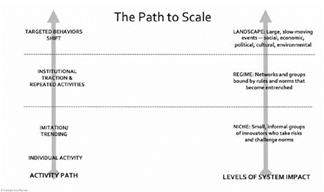
Figure 7 A framework for measurement. On the left are types of activities that might be measured to mark when a disruptive idea is transcending layers of Geel’s multi-level analysis, pictured on the right. Elements of the MLA are from Geels (2005).
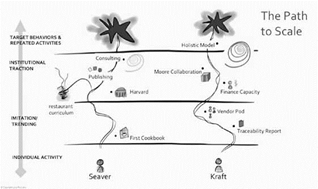
Credit: Dahle.
Figure 8 A path to scale. This framework tracks the disruptive ideas of two individuals in our Future of Fish cohort along the path to ascending the layers of the multi-level Analysis. Future of Fish or these cohort members initiated all of the projects listed.
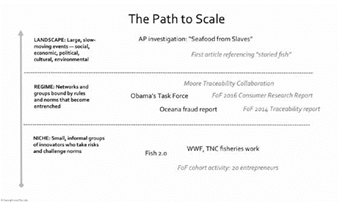
Figure 9 Amplifying activities. This chart tracks the work of Future of Fish, as well as other entities, that attempted to influence the trajectory of the disruptive ideas of “storied fish” and “traceability technology.”
Sometimes, the most important breakthroughs come in pedestrian packages. Additionally, in Transition Design, there is no such thing as a clean slate. Any idea you might have, there is likely already a nonprofit or government program that has seeds of that concept, perhaps executed badly or grossly underfunded, but seeds nonetheless. The more effective and efficient path (but certainly the less flashy and creative one, from a traditional designer’s point of view) is to work with the existing idea to make it better, not to build a perfect castle in the air that will never be built on the ground. The role for professional designers, then, is to become facilitators for others to design.
At the outset of Future of Fish, we began to think about the design process as a torch that is passed from us (the professional team of researchers and analysts) to the system participants (nonprofit leaders, entrepreneurs, visionary civic officials) and back. We center the system participants and the users they serve simply because they produce the best ideas and they are also the ones who have the skills, network, and commitment to execute them. As we learned from our own formative experience, nonprofits do not like to be told what to do by outsiders. Why not create a pathway that makes them an integral part of the design team? Multiple models and variations of this idea are emerging currently. At one extreme on the spectrum are programs and initiatives that aim to teach participants the design process and expect them to run all facets of it, including field research, either with some guidance at episodic meetings or entirely on their own using toolkits. At the other extreme is design consulting, which involves participants as educators to the designer, who invent the idea and hand it off to the sponsor organization to implement at the end. We’ve created a different division of responsibilities in which the professional team supports and services system participants while handling some of the tasks where expertise is critical (for example, field observation). Figure 10 illustrates our process. Anthropologists or researchers do all of the initial research and fieldwork. Then we convene a series of workshops with system participants and innovators whom we discovered in that research process, along with other expertise we know needs to be in the room. For example, when we convened a design workshop on building more oyster reefs, we included companies and nonprofits that have shell-recycling programs. Finance is an oft-missing capacity in social innovation brainstorms, so we ensure that knowledge is present. We also recruit “creative agitators,” people who have solved problems in other disciplines or who bring artistic approaches to sense making, such as writers or actors. The goal is to create a process that gives these leaders both the permission to come up with new ideas and the typically missing expertise to flesh them out. After these workshops, we collaborate with participants remotely to draft their ideas into funding proposals, which we submit to foundations. Typically we work ahead of the design workshops to line up interested funders. Then we head into prototyping, with the project champions from the workshop receiving funds as well as support from Future of Fish to coordinate, facilitate, or recruit other team members as needed. Many other methods for social innovation, including social labs, put a much heavier responsibility on participants to self-organize and fundraise. Our method takes more investment from us as a project manager and convener, which we think pays off with more projects moving forward.
Funders do not often fund this whole process from start to finish. Our original cycle of the process was funded by one foundation. But as we repeated this co-design process,
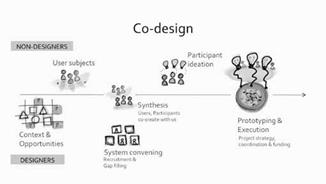
Figure 10 Co-design. Future of Fish’s process for co-designing. Note the leadership of non designers in roles that were traditionally reserved for designers.
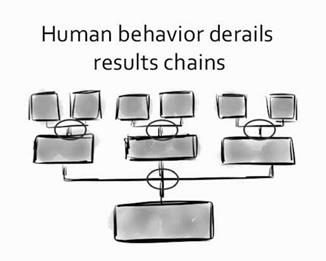
Figure 11 Potential of transition design. Each of the circled junctions are moments when an abstract mapping of cause and effect in a system can be derailed by stuck points of entrenched human behavior. Results chain mapping does not account for a humancentered view of change. Using transition design can identify these stuck points and create new pathways for people in systems.
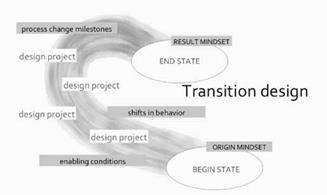
Figure 12 Multiple layers of design. In transition design as Future of Fish practiced it, we ran multiple design initiatives to address stuck points for multiple users to get to our desired end state of fish being valued.
taking on different slices of system challenges at each round, we found that breaking the process into three phases was easier to sell. Each phase -research, convening and piloting- produces specific deliverables that make the next phase more knowable. Funders like to have more certainty about what they are buying, rather than agreeing to the whole open-ended process up front. This is a cultural challenge for the world of philanthropy, whose myopic focus on outcome tables and deliverables often stifles the kind of innovation necessary to navigate complexity. The authors Kania, Kramer, and Russell (2014) call out the failure of foundations to distinguish between simple, complicated, and complex problems and pick the right tools to address them. Simple and complicated problems can mostly be addressed by straightforward, if difficult, sets of activities. They are linear and more predictable in their paths to solutions. Kania et al. (2014) give the example of building a hospital as a simple, though ambitious, challenge. A complicated problem would be developing a vaccine -a challenging process indeed, but with the right resources, one that produces known outcomes in a predictable timeline. These problems are appropriate for “strategic philanthropy”, which invests in mapping theories of change, results-chains, and five-year execution path predictions, as Kania and his co-authors describe. But they argue that complex, systemic problems, ones for which no linear paths exist, must develop more emergent strategies.
We have repeatedly felt a nagging suspicion that the conventional tools of strategic philanthropy just don’t fit the realities of social change in a complex works. We have now come to the conclusion that if funders are to make greater progress in meeting society’s urgent challenges, they must move beyond today’s rigid and predictive model of strategy to a more nuanced model of emergent strategy that better aligns with the complex nature of social progress. (Kania et al., 2014, p. 26)
Transition Design should be in that new toolkit. Early on in our work, before Future of Fish was an initiative, a strategy consultant working with multiple foundations on sustainable fish asked for my feedback on a results-chain document that mapped the ideal flow of unfolding change in marine fisheries. He pushed across the desk a very tidy stacked-box illustration showed one improvement causing three more improvements, which triggered another six, etc. (See Figure 11). I drew circles with my red pen around each of the links between events and said, “The problem is that in between that event and the next outcome are many people who are very happy with the status quo and likely incentivized by current system conditions to keep doing exactly what they’re doing. Why are they going to change behavior?” He didn’t like that response for obvious reasons.
That is the very reason Transition Design can be so powerful: it is exactly the right lens to discover where human behavior is the barrier to change, and what to do about it. As Future of Fish, to the best of our ability, we have applied this method repeatedly, addressing different “stuck points” to the behavior changes we want to see, at multiple levels (See Figure 12). The reasons tuna fishers in Indonesia resist digitization are very different from the reasons middlemen in North America resist it. But we have mapped them both and have been able to suggest strategies to shift those behaviors. Transition Design can be applied to any system in this manner, identifying major stuck points, as we did with the middle of the supply chain, and offering new ways to re-align the system.
Kania et al. (2014) conclude by suggesting the foundations try “co-creating strategy” with other actors in the system, including grantees. I would argue that a more bold and appropriate step would be to let the nonprofits, innovators, and users/beneficiaries themselves lead the design of the strategies. Like Future of Fish, foundations might provide the expert support these groups need to generate creative ideas and solutions using a Transition Design process. That idea leads to some interesting opportunities to shift not only the power dynamics of the complex problems we seek to solve but also the power dynamics of how we solve them. Transition Design could allow the voices of those closest to the problem -those experiencing it and those on the front lines of solving it- to have a stronger voice in deciding what solutions get created. That seems like an excellent starting point for creating a more sustainable and just world.














